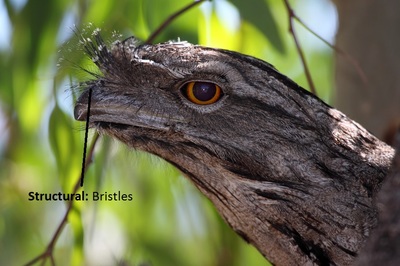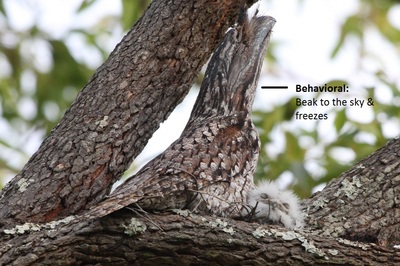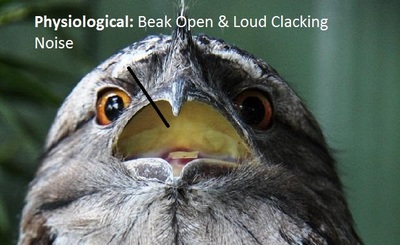Tawny Frogmouth's Adaptations
Structural: The Tawny Frogmouth has bristles that is located on the base of its beak. This protects the face and eyes of the Tawny Frogmouth from its prey. The bristles assist the Tawny Frogmouth from getting bitten or stung from its prey, which can cause harm or death to the Tawny Frogmouth.
Behavioural: Once the Tawny Frogmouth is alarmed, it points it’ beak to the sky and freezes. This assists them in survival as they are camouflaged and look like a dead branch.
Physiological: When the Tawny Frogmouth is threatened, it opens its beak which has a bright yellow lining and starts making loud clacking noises to scare off the threat. This adaptation assists them in survival and also to protect their chicks from any predators.
Behavioural: Once the Tawny Frogmouth is alarmed, it points it’ beak to the sky and freezes. This assists them in survival as they are camouflaged and look like a dead branch.
Physiological: When the Tawny Frogmouth is threatened, it opens its beak which has a bright yellow lining and starts making loud clacking noises to scare off the threat. This adaptation assists them in survival and also to protect their chicks from any predators.
Labeled diagram of the Tawny Frogmouth adaptations, created on Paint
Source:
https://i0.wp.com/www.davidkphotography.com/images/20091215192822_tawny-frogmouth.jpg
http://www.bushpea.com/bd/ph/laz/im/tawny%20frogmouth%2003.jpg
http://www.zoo.org.au/sites/default/files/styles/zv_carousel_large/public/Tawny-openmouth-web620.jpg?itok=YhtTlBzv
Source:
https://i0.wp.com/www.davidkphotography.com/images/20091215192822_tawny-frogmouth.jpg
http://www.bushpea.com/bd/ph/laz/im/tawny%20frogmouth%2003.jpg
http://www.zoo.org.au/sites/default/files/styles/zv_carousel_large/public/Tawny-openmouth-web620.jpg?itok=YhtTlBzv



